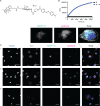A Lysosome-Targeted Tetrazine for Organelle-Specific Click-to-Release Chemistry in Antigen Presenting Cells
- PMID: 37269296
- PMCID: PMC10273227
- DOI: 10.1021/jacs.3c02139
A Lysosome-Targeted Tetrazine for Organelle-Specific Click-to-Release Chemistry in Antigen Presenting Cells
Abstract
Bioorthogonal deprotections are readily used to control biological function in a cell-specific manner. To further improve the spatial resolution of these reactions, we here present a lysosome-targeted tetrazine for an organelle-specific deprotection reaction. We show that trans-cyclooctene deprotection with this reagent can be used to control the biological activity of ligands for invariant natural killer T cells in the lysosome to shed light on the processing pathway in antigen presenting cells. We then use the lysosome-targeted tetrazine to show that long peptide antigens used for CD8+ T cell activation do not pass through this organelle, suggesting a role for the earlier endosomal compartments for their processing.
Conflict of interest statement
The authors declare no competing financial interest.
Figures






Similar articles
-
Bioorthogonal Tetrazine Carbamate Cleavage by Highly Reactive trans-Cyclooctene.J Am Chem Soc. 2020 Jun 24;142(25):10955-10963. doi: 10.1021/jacs.0c00531. Epub 2020 Jun 10. J Am Chem Soc. 2020. PMID: 32453557
-
Transition-Metal-Mediated versus Tetrazine-Triggered Bioorthogonal Release Reactions: Direct Comparison and Combinations Thereof.Chempluschem. 2020 Aug;85(8):1669-1675. doi: 10.1002/cplu.202000477. Chempluschem. 2020. PMID: 32757364
-
Synthesis and radiolabeling of a polar [125 I]I-1,2,4,5-tetrazine.J Labelled Comp Radiopharm. 2023 Jan;66(1):22-30. doi: 10.1002/jlcr.4009. Epub 2022 Dec 30. J Labelled Comp Radiopharm. 2023. PMID: 36539610 Free PMC article.
-
IEDDA: An Attractive Bioorthogonal Reaction for Biomedical Applications.Molecules. 2021 Jul 30;26(15):4640. doi: 10.3390/molecules26154640. Molecules. 2021. PMID: 34361793 Free PMC article. Review.
-
Tetrazine bioorthogonal chemistry makes nanotechnology a powerful toolbox for biological applications.Nanoscale. 2023 Jan 5;15(2):461-469. doi: 10.1039/d2nr06056f. Nanoscale. 2023. PMID: 36533721 Review.
Cited by
-
Manipulating DNA and RNA structures via click-to-release caged nucleic acids for biological and biomedical applications.Nucleic Acids Res. 2025 Jun 20;53(12):gkaf571. doi: 10.1093/nar/gkaf571. Nucleic Acids Res. 2025. PMID: 40598897 Free PMC article.
-
Rational Design of Biocompatible Ir(III) Photosensitizer to Overcome Drug-Resistant Cancer via Oxidative Autophagy Inhibition.Adv Sci (Weinh). 2025 Jan;12(2):e2407236. doi: 10.1002/advs.202407236. Epub 2024 Nov 14. Adv Sci (Weinh). 2025. PMID: 39540573 Free PMC article.
-
Bioorthogonal Chemistry in Cellular Organelles.Top Curr Chem (Cham). 2023 Dec 16;382(1):2. doi: 10.1007/s41061-023-00446-5. Top Curr Chem (Cham). 2023. PMID: 38103067 Free PMC article. Review.
-
Mutually Orthogonal Bioorthogonal Reactions: Selective Chemistries for Labeling Multiple Biomolecules Simultaneously.Top Curr Chem (Cham). 2024 Jul 6;382(3):24. doi: 10.1007/s41061-024-00467-8. Top Curr Chem (Cham). 2024. PMID: 38971884 Free PMC article. Review.
-
trans-Cyclooctene-caged-IL-1β immunocytokine-constructs ligated to unmodified nanobodies allow click-2-release-based control of cytokine activity.RSC Chem Biol. 2025 Jun 4;6(7):1068-1078. doi: 10.1039/d5cb00113g. eCollection 2025 Jul 2. RSC Chem Biol. 2025. PMID: 40502805 Free PMC article.
References
-
- Rossin R.; van Duijnhoven S. M.; Ten Hoeve W.; Janssen H. M.; Kleijn L. H.; Hoeben F. J.; Versteegen R. M.; Robillard M. S. Triggered Drug Release from an Antibody-Drug Conjugate Using Fast ″Click-to-Release″ Chemistry in Mice. Bioconjugate Chem. 2016, 27, 1697.10.1021/acs.bioconjchem.6b00231. - DOI - PubMed
Publication types
MeSH terms
Substances
LinkOut - more resources
Full Text Sources
Research Materials

